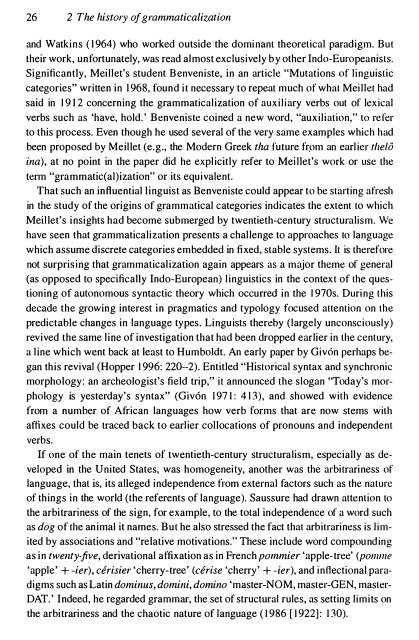Gram - SEAS
Gram - SEAS
Gram - SEAS
You also want an ePaper? Increase the reach of your titles
YUMPU automatically turns print PDFs into web optimized ePapers that Google loves.
26 2 The histOlY of gramm atica liz at ion<br />
and Watkins (1964) who worked outside the dominant theoretical paradigm. But<br />
their work, unfortunately, was read almost exclusively by other Indo-Europeanists.<br />
Significantly, Meillet's student Benveniste, in an article "Mutations of linguistic<br />
categories" written in 1968, found it necessary to repeat much of what Meillet had<br />
said in 1912 concerning the grammaticalization of auxiliary verbs out of lexical<br />
verbs such as 'have, hold.' Benveniste coined a new word, "auxiliation," to refer<br />
to this process. Even though he used several of the very same examples which had<br />
been proposed by Meillet (e.g., the Modern Greek tha future fr.om an earlier tile/a<br />
ina), at no point in the paper did he explicitly refer to Meillet's work or use the<br />
term "grammatic(al)ization" or its equivalent.<br />
That such an influential linguist as Benveniste could appear to be starting afresh<br />
in the study of the origins of grammatical categories indicates the extent to which<br />
MeilIet's insights had become submerged by twentieth-century structuralism. We<br />
have seen that grammaticalization presents a challenge to approaches to language<br />
which assume discrete categories embedded in fixed, stable systems. It is therefore<br />
not surprising that grammaticalization again appears as a major theme of general<br />
(as opposed to specifically Indo-European) linguistics in the context of the questioning<br />
of autonomous syntactic theory which occurred in the I 970s. During this<br />
decade the growing interest in pragmatics and typology focused attention on the<br />
predictable changes in language types. Linguists thereby (largely unconsciously)<br />
revived the same line of investigation that had been dropped earlier in the century,<br />
a line which went back at least to Humboldt. An early paper by Givan perhaps began<br />
this revival (Hopper 1996: 220-2). Entitled "Historical syntax and synchronic<br />
morphology: an archeologist's field trip," it announced the slogan "Today's morphology<br />
is yesterday's syntax" (Givan 1971: 413), and showed with evidence<br />
from a number of African languages how verb forms that are now stems with<br />
affixes could be traced back to earlier collocations of pronouns and independent<br />
verbs.<br />
If one of the main tenets of twentieth-century structuralism, especially as developed<br />
in the United States, was homogeneity, another was the arbitrariness of<br />
language, that is, its alleged independence fi·om external factors such as the nature<br />
of things in the world (the referents of language). Saussure had drawn attention to<br />
the arbitrariness of the sign, for example, to the total independence of a word such<br />
as dog of the animal it names. But he also stressed the fact that arbitrariness is limited<br />
by associations and "relative motivations." These include word compounding<br />
as in twenty-five, derivational affixation as in French pommier 'apple-tree' (pol1ll1le<br />
'apple' + -ier), cerisier 'cherry-tree' (cerise 'cherry' + -ier), and inflectional paradigms<br />
such as Latin dominus, domini, domino 'master-NOM, master-GEN, master<br />
DAT.' Indeed, he regarded grammar, the set of structural rules, as setting limits on<br />
the arbitrariness and the chaotic nature of language (1986 [1922]: 130).
















